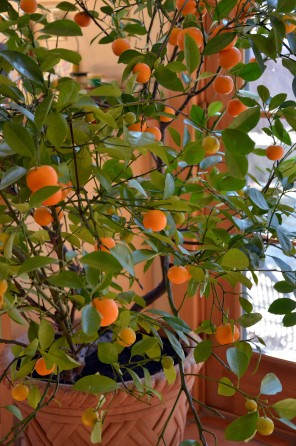http://www.washingtonpost.com/lifestyle/home-garden/calamondin-orange-the-best-behaved-citrus-tree/2012/04/03/gIQAzMm5uS_story.html
Calamondin orange, the best-behaved citrus tree
By Barbara Damrosch, Published: April 4
 (Barbara Damrosch/The Washington Post) -
(Barbara Damrosch/The Washington Post) -
The calamondin, wintering by a sunny window,
produces fruit throughout the year.
This winter the Ponderosa lemon bloomed so heavily it perfumed the whole downstairs. The Meyer lemon is ripening its smooth-skinned yellow fruit. But the calamondin is the golden girl, its branches drooping with bright orange globes an inch-and-a-half wide. Every visitor remarks on its beauty.
A calamondin is a type of citrus tree normally sold and grown as an ornamental, for outdoor display in mild climates and as a houseplant for the rest of us. I like to have it both ways, so mine will soon be going out on the terrace for the summer. One of the hardiest citrus, it will take a bit of frost, so it will be the first to move, protected at first from direct sun by the shade of a pine and then brought into the open a few weeks later.
Of all the citrus Ive grown, its the best behaved. The glossy green foliage resists the scale and spider mites to which the lemons are prone, remaining thick and lush. Last fall its leaves took on a yellow hue, but this was remedied within days by a dose of chelated iron, a soluble remedy for iron deficiency in plants. I used a formulation with 4.7 percent iron and watered it just once at the rate of one tablespoon per half gallon of water.
Calamondins great looks have distracted from its use as an edible fruit. Snip a ripe one off the branch with scissors, pop it in your mouth, and youll find it tart but not lemon-tart: more like a kumquat, with thin, sweet rind, juicy acid flesh and few seeds.
If you had enough fruits you could make a fine juice from it, but I use it sparingly in dishes where I want just a hint of orangy flavor. For instance, a little squeeze of the juice and very thin slices of the rind, added to olive oil, make a fine salad dressing. I whisk in a tiny bit of honey and sprinkle it over cold lobster with some tarragon. The fruits yield a fabulous marmalade, a syrup to pour over ice cream or a glaze for a cake.
I also love to season beef dishes with the peel, the way you would use orange in Mandarin beef, or in a Provencal daube. Recently I chopped up two fruits and added them to short ribs I was braising, along with a little tawny port. Even that tiny amount transformed the dish.
One reason this plant is so gorgeous is that it blooms in spurts all year long and is rarely without those little orange globes. Since it is self-fertile, you dont have to worry about it being pollinated while it is taking its winter semester in your sunny window. But as you discover more uses for that distinctive flavor (in teas! in cocktails!), you do worry about robbing the plant too heavily. Though numerous, the fruits take many months to ripen from green to yellow to orange.
I keep my calamondin tree pruned to about five feet tall, measured from the bottom of the pot, and about the same distance wide. Any larger and I couldnt move it inside and out. Clearly I need a few more of them, wherever theres a well-lit spot. And maybe a kumquat.
Damrosch is a freelance writer and the author of The Garden Primer.




